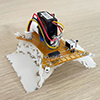Abstract
We present CurveQuad, a miniature curved origami quadruped that is able to self-fold and unfold, crawl, and steer, all using a single actuator. CurveQuad is designed for planar manufacturing, with parts that attach and stack sequentially on a flat body. The design uses 4 curved creases pulled by 2 pairs of tendons from opposite ends of a link on a 270deg servo. It is 8 cm in the longest direction and weighs 10.9 g. Rotating the horn pulls the tendons inwards to induce folding. Continuing to rotate the horn shears the robot, enabling the robot to shuffle forward while turning in either direction. We experimentally validate the robot’s ability to fold, steer, and unfold by changing the magnitude of horn rotation. We also demonstrate basic feedback control by steering towards a light source from a variety of starting positions and orientations, and swarm aggregation by having 4 robots simultaneously steer towards the light. The results demonstrate the potential of using curved crease origami in self-assembling and deployable robots with complex motions such as locomotion.
Publisher source: https://ieeexplore.ieee.org/document/10342339
Paper full text: https://repository.upenn.edu/handle/20.500.14332/58861
Fabrication Files
Laser Cut Files
- Servo Mount
- Tendons: 18.1mm, 18.6mm
- Main Body Sheet
3D Print Files
- Battery and Servo mount: upper piece attaching to servo, lower piece holding battery, spacer
- Servo Horn: upper piece attaching to servo, middle bar, lower cap
Circuit Design Files
- Gerber files
- EAGLE files: sch, brd, lbr
Related Publication
 | CurveQuad: A centimeter-scale origami quadruped that leverages curved creases to self-fold and crawl with one motor (Conference) IEEE/RSJ International Conference on Intelligent Robots and Systems (IROS), 2023. |
BibTeX (Download)
@conference{feshbach2023curvequad,
title = {CurveQuad: A centimeter-scale origami quadruped that leverages curved creases to self-fold and crawl with one motor},
author = {Daniel Feshbach and Xuelin Wu and Satviki Vasireddy and Louis Beardell and Bao To and Yuliy Baryshnikov and Cynthia Sung},
url = {https://www.youtube.com/watch?v=RnSHG5F2Iek&ab_channel=SungRoboticsGroup
https://sung.seas.upenn.edu/publications/curvequad/},
doi = {10.1109/IROS55552.2023.10342339},
year = {2023},
date = {2023-10-01},
urldate = {2023-10-01},
booktitle = {IEEE/RSJ International Conference on Intelligent Robots and Systems (IROS)},
abstract = {We present CurveQuad, a miniature curved origami quadruped that is able to self-fold and unfold, crawl, and steer, all using a single actuator. CurveQuad is designed for planar manufacturing, with parts that attach and stack sequentially on a flat body. The design uses 4 curved creases pulled by 2 pairs of tendons from opposite ends of a link on a 270deg servo. It is 8 cm in the longest direction and weighs 10.9 g. Rotating the horn pulls the tendons inwards to induce folding. Continuing to rotate the horn shears the robot, enabling the robot to shuffle forward while turning in either direction. We experimentally validate the robot’s ability to fold, steer, and unfold by changing the magnitude of horn rotation. We also demonstrate basic feedback control by steering towards a light source from a variety of starting positions and orientations, and swarm aggregation by having 4 robots simultaneously steer towards the light. The results demonstrate the potential of using curved crease origami in self-assembling and deployable robots with complex motions such as locomotion.},
keywords = {2023, origami, project_CurveQuad, self-folding},
pubstate = {published},
tppubtype = {conference}
}
Acknowledgments
The work was supported in part by the Army Research Office (ARO) under MURI Award #W911NF1810327, by NSF Grant #1845339, by the Johnson & Johnson WiSTEM2D Scholars Program, and by the Office of Naval Research (ONR) Award #N00014-23-1-2068. Any opinions, findings, and conclusions or recommendations expressed in this material are those of the author(s) and do not necessarily reflect the views of funding source.
